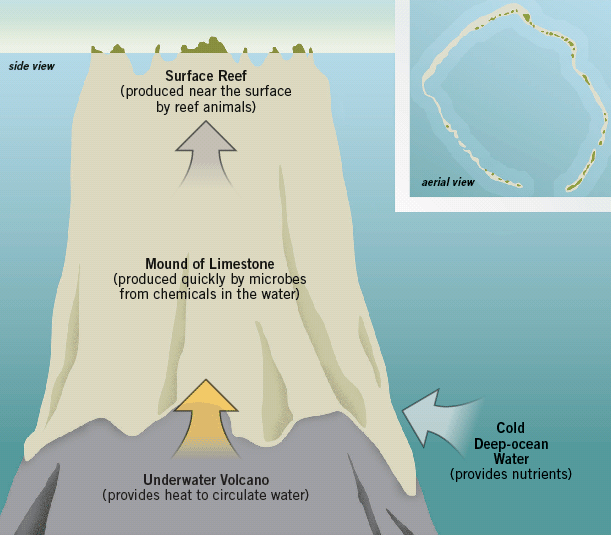Massive Modern Reefs—Finding Time to Grow
Modern ocean reefs can be quite massive, sometimes thousands of feet thick. How is it possible to get such thick reefs, if they had only a few thousand years to grow, after the Flood?
The term reef conjures up images of an underwater wonderland—a beautiful and colorful spectacle of living animals such as corals, sponges, fish, and other exotic sea creatures, where snorkelers and divers love to congregate. Unseen beneath the corals is a massive limestone framework, built up slowly, inch by inch, as organisms die and leave behind their hard skeletons. How was it possible for these coral reefs—sometimes thousands of feet thick—to grow in the short time since Noah’s Flood about 4,400 years ago?
The most famous of all living reefs is Australia’s Great Barrier Reef, actually a series of 3,000 smaller reefs that stretch some 1,600 miles (2,600 km) along the continent’s northeastern coast. At its thickest, the reef is over 400 feet (120 m) thick. But this is nothing compared to one of the world’s thickest “reefs”—the Eniwetok (Enewetak) Atoll, located in the Pacific’s Marshall Islands. Drilling operations in the 1950s revealed nearly a mile (4,050 feet, or 1,230 m) of limestone material resting on an underwater volcano.1 Has there been enough time for such thick accumulations to form since the Flood?2
Reef Growth Rates
Skeptics often make the mistake of assuming that the slow processes we see today have always operated at the same rate. They point to modern corals, which usually require well-lit, warm shallow water in which to grow. If the corals were in deeper water, their limestone skeletons would dissolve in the colder environment. The corals’ growth would also be inhibited in deeper water because they usually partner with various photosynthetic organisms, such as algae, that can grow best near the surface where sunlight is abundant.
These new ideas have led to a reasonable hypothesis that can easily explain the growth.
But what if the temperatures and mix of microorganisms were very different?
Before looking at the conditions that would allow quicker reef growth, however, it is necessary to understand a bit more about the behavior of modern corals. Corals are living animals that feed by filtering small organisms out of sea water, but they also get nutrients from photosynthetic algae and other small organisms that live within their cells. Like plants on land, these amazing organisms use photosynthesis to convert the sun’s energy into chemical energy.
Corals spend their whole lives in a single location, as new generations grow on top of old ones. How fast a reef grows depends on a balance between constructive and destructive processes. But these complex, dynamic processes have proved difficult to measure.
On the one hand, the reef framework grows as corals grow and various kinds of debris are cemented together. At the same time, a number of processes can quickly destroy the reef, including bio-eroders (such as parrotfish and sea urchins), chemical dissolution, boring organisms (such as sponges, clams, and various worms), and powerful storms like hurricanes. Boring organisms are so prevalent that nearly every piece of limestone in a reef contains holes. Waves from large storms and tsunamis can break off pieces of the reef rock and destroy it, sometimes casting large blocks on top of the reef, which can become a new island rising above the submerged reef.
It is important to realize that coral growth rates are not equivalent to reef growth rates. Corals can be destroyed by the various processes mentioned above, which in turn causes the reef to shrink. Reef volume can increase only as living animals and the remains of dead ones become cemented together to form the reef framework. The growth rate of a reef is slower than the growth rate of the fastest-growing corals.
With these facts in mind, it is possible to look at various reports of coral and reef growth rates. Ariel A. Roth has summarized many of these studies and found reef growth rates between 99 and 432 mm/year.3 Reefs grow exceptionally fast in some cases, however. Ships’ hitting coral reefs in well-charted waters might only be explained by rapid growth.4
Rapid and large coral growth has been noted on sunken ships in the decades since World War II.5 Acropora (a common species of coral) colonies have been noted to reach 24–31 inches (60–80 cm) in diameter in just 4.5 years in some experimental studies.6 Fast upward growth rates are possible only until a growing reef reaches sea level. After that, growth rates are often very slow and can continue upward only if the seafloor sinks or if sea level rises.
Growth of the Eniwetok Atoll
So, how might the Eniwetok Atoll have grown since the end of the Flood? Claims are made that this is impossible, proving the earth is very old.7 With the growth rates that have been cited, though, it is possible for the island to have reached sea level in 4,400 years, but there is more to the story. Reefs typically don’t begin growing in deep water, and in shallow water they usually grow slowly. Yet drilling operations in the 1950s confirmed that Eniwetok rises from a volcanic base nearly a mile underwater.
At these depths corals and limestone normally do not accumulate. The drilling did not find corals but large caverns and “chalky” limestone mud deep under the island. Corals did not become common until very late in the island’s history.
So the drillers found that most of the island was not built of corals at all, but of hard limestone mud! There was no reef framework like we see in most coral reefs today. Indeed, we now know that microbes play a major role in helping limestone and other chemicals to precipitate out of water, both in ancient and modern settings.8 Microbes are small single-celled organisms, including bacteria. Active microbes in seawater during and after the Flood may help solve several geological puzzles, including this one.
How can microbes explain the chalky limestone, the large caverns, and the thick accumulation of “reef” material? Microbes living at depth (very happily in warm volcanic water) may have produced the mound of “chalky” limestone material on the underwater volcano. Hot acidic water from the volcano may then have dissolved some of the limestone, making the large caverns that the drilling encountered. As warm water rose upward, cooler nutrient-rich water was drawn into the lower caverns from the surrounding ocean.
This process has been described as geothermal endo-upwelling (see Figure and text of figure for explanation). It has been described in modern reefs and is suggested for some of the ancient Pacific reefs,9 including the Eniwetok Atoll. 10 This process delivers needed nutrients to corals living at sea level, including nitrogen, phosphorus, silicon, carbon dioxide, oxygen, and magnesium. The right combination of nutrients, active microbes, and heat may have allowed the underwater island to grow upward at a rapid pace. As the limestone mound approached sea level, reef corals became permanently established and thrived with the help of the steady upward flow of nutrient-rich water.
Eniwetok Atoll, Pacific Ocean

Hypothesis for Rapid Reef-Building: Geothermal Endo-Upwelling
How was one of the world’s thickest “reefs,” the 4,050-foot (1,230 m) Eniwetok Atoll in the Pacific Ocean, built so quickly after the Flood? A process called “geothermal endo-upwelling” could be the answer. The underwater volcano provided heat to draw cold, nutrient-rich water into a growing mound of limestone. Microbes helped to precipitate lime out of the water until it got near the surface, when reef animals began to live on the mound. Drilling showed that the mound consists mostly of “chalky” limestone material, not coral reef organisms.
Important Lessons
Several lessons might be learned from Eniwetok Atoll. First, we must be cautious about extending present-day rates and processes into the past. We can’t just assume constant rates and processes all through history, as the majority of geologists often do. This way of thinking is called uniformitarianism and has led to many “wrong turns” in geology. Everyone assumed that Eniwetok Atoll was built from the bottom up out of corals and that it had grown very slowly, just like the corals living around the island today. What a surprise when the drilling encountered chalky limestone and caverns instead of reef material!
Secondly, additional data and knowledge of new processes often change our scientific explanations. In this example, we have further understanding of how the island was built by learning and knowing more about microbes and geothermal endo-upwelling. Understanding these relatively new ideas has led to reasonable hypotheses that can easily explain the growth of this island in post-Flood times and add even more confirmation of the truth of Genesis.
Finally, it appears that corals can grow quickly if the right conditions are present. When we investigate various claims against the truth of God’s Word, we often find abundant evidence that shows the critics are wrong and God’s Word is true!
Answers Magazine
January – March 2013
Learn about our culture's newest tactics in the battle for kids' souls, and discover what you can do in your home and church to reclaim our youth for Jesus, the Creator. In addition to this special section of three articles, you'll find all the creation content you expect from Answers magazine, including a look at Lucy, the famous ape; animals with "sixth senses"; ancient and modern reefs; and intriguing findings about the animal kinds on Noah's Ark.
Browse IssueFootnotes
- H. S. Ladd and S. O. Schlanger, “Drilling Operations on Eniwetok Atoll,” U.S. Geological Survey Professional Paper 260-Y (1960): 863–903.
- Interested readers should refer to my book chapter “Modern and Ancient Reefs” in Rock Solid Answers, ed. M. J. Oard and J. K. Reed (Green Forest, Arkansas: Master Books, 2009), pp. 149–166) for a more detailed discussion of this topic.
- A. A. Roth, Origins Linking Science and Scripture (Hagers-town, Maryland: Review and Herald Publishing Association, 1998).
- H. S. Ladd, “Reef Building,” Science 134 no. 3481 (1961): 703–715.
- S. A. Earle, “Life Springs from Death in Truk Lagoon,” National Geographic 149 no. 5 (1976): 578–603.
- H. E. Fox, “Rapid Coral Growth on Reef Rehabilitation Treatments in Komodo National Park, Indonesia,” Coral Reefs 24 (2005): 263.
- D. E. Wonderly, God’s Time-Records in Ancient Sediments (1977; repr., Hatfield, Pennsylvania: Interdisciplinary Biblical Research Institute, 1999).
- R. E. Riding and S. M. Awramik, eds., Microbial Sediments (Berlin: Springer-Verlag, 2000).
- F. Rougerie and J. A. Fagerstrom, “Cretaceous History of Pacific Basin Guyot Reefs: A Reappraisal Based on Geothermal Endo-upwelling,” Palaeogeography, Palaeoclimatology, Palaeoecology 112 (1994): 239–260.
- A. H. Saller and R. B. Koepnick, “Eocene to Early Miocene Growth of Eniwetok Atoll: Insight from Strontium-Isotope Data,” Geological Society of America Bulletin 102 no. 3 (1990): 381–390.

Answers in Genesis is an apologetics ministry, dedicated to helping Christians defend their faith and proclaim the good news of Jesus Christ.
- Customer Service 800.778.3390
- Available Monday–Friday | 9 AM–5 PM ET
- © 2025 Answers in Genesis




